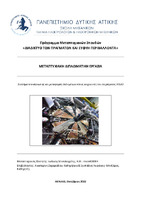| dc.contributor.advisor | ZACHARIADOU, KATERINA | |
| dc.contributor.advisor | Kyriakis-Bitzaros, Efstathios | |
| dc.contributor.author | Μεσολογγίτης, Ιωάννης | |
| dc.date.accessioned | 2023-05-03T11:48:51Z | |
| dc.date.available | 2023-05-03T11:48:51Z | |
| dc.date.issued | 2022-12 | |
| dc.identifier.uri | https://polynoe.lib.uniwa.gr/xmlui/handle/11400/4299 | |
| dc.identifier.uri | http://dx.doi.org/10.26265/polynoe-4138 | |
| dc.description.abstract | To benefit from the expected increase in luminosity of the upgraded LHC accelerator, the detector system "New Small Wheel (NSW)" replaced the innermost detection station in the forward region of the ATLAS Muon Spectrometer. NSW features two new detector technologies; the resistive Micromegas detectors (MM) and the small strip Thin Gap Chambers (sTGC), comprising more than 2 million readout channels. The large number of readout channels, the high data rates, and the harsh conditions under which the NSW will operate pose significant challenges to its trigger and data acquisition system. The Level-1 Data Driver Card (L1DDC) boards are part of the NSW detector electronics. Three types of L1DDC boards had massively been produced; two for the readout chain of the MMs and sTGCs and one for the trigger electronics chain of the sTGCs. A fully automated testing setup has been developed to evaluate the performance of 1184 L1DDC boards that have been tested at four testing sites; at the University of West Attica (UNIWA), the National Kapodistrian University of Athens (NKUA), the National Centre for Scientific Research (NCSR
Demokritos), and CERN. Besides the L1DDCs testing setup development and the L1DDCs' performance evaluation and debugging, several off-detector boards have been designed and tested to address several problems of the NSW electronic systems that emerged during their integration on the detector. The most critical one was the severe noise problems which jeopardized the on-time installation of the NSW on the ATLAS detector given the LHC run startup. All possible noise sources have been investigated, and adequate repairs have been performed. The primary noise source has been identified to be the power supplies that power all the detector electronics. A filter has been designed and implemented on a mezzanine board hosted on the ICS power supplies' front panels reducing the noise to acceptable levels. The mezzanine boards (128) carrying the UNIWA logo have been installed on the NSW detector (Side-C) and the spare ICSes. | el |
| dc.format.extent | 93 | el |
| dc.language.iso | en | el |
| dc.publisher | Πανεπιστήμιο Δυτικής Αττικής | el |
| dc.rights | Αναφορά Δημιουργού - Μη Εμπορική Χρήση - Παρόμοια Διανομή 4.0 Διεθνές | * |
| dc.rights | Αναφορά Δημιουργού-Μη Εμπορική Χρήση 4.0 Διεθνές | * |
| dc.rights.uri | http://creativecommons.org/licenses/by-nc/4.0/ | * |
| dc.subject | CERN | el |
| dc.subject | Large hadron collider | el |
| dc.subject | LHC | el |
| dc.subject | ATLAS experiment | el |
| dc.subject | New Small Wheel | el |
| dc.subject | NSW | el |
| dc.subject | Micromegas | el |
| dc.subject | sTGC | el |
| dc.subject | L1DDC | el |
| dc.subject | FPGA | el |
| dc.subject | Clock distribution board | el |
| dc.title | Readout and data transfer systems in the detectors of the ATLAS experiment | el |
| dc.title.alternative | Συστήματα ανάγνωσης και μεταφοράς δεδομένων στους ανιχνευτές του πειράματος ATLAS | el |
| dc.type | Μεταπτυχιακή διπλωματική εργασία | el |
| dc.contributor.committee | Kaltsas, Grigoris | |
| dc.contributor.committee | Πάτσης, Γεώργιος | |
| dc.contributor.faculty | Σχολή Μηχανικών | el |
| dc.contributor.department | Τμήμα Ηλεκτρολόγων και Ηλεκτρονικών Μηχανικών | el |
| dc.contributor.master | Διαδίκτυο των Πραγμάτων και Ευφυή Περιβάλλοντα | el |
| dc.description.abstracttranslated | Με βάση την αναμενόμενη αύξηση της φωτεινότητας του αναβαθμισμένου επιταχυντή LHC, το σύστημα ανιχνευτών "New Small Wheel (NSW)" αντικατέστησε τον εσωτερικότερο σταθμό ανίχνευσης στην εμπρόσθια περιοχή του φασματόμετρου μιονίων ATLAS. Το NSW διαθέτει δύο νέες τεχνολογίες ανιχνευτών: τους ανιχνευτές Micromegas (MM) και τους small strip Thin Gas Chambers (sTGC), που περιλαμβάνουν περισσότερα από 2 εκατομμύρια κανάλια ανάγνωσης. Ο μεγάλος αριθμός καναλιών ανάγνωσης, οι υψηλοί ρυθμοί δεδομένων και οι δύσκολες συνθήκες υπό τις οποίες θα λειτουργεί το NSW θέτουν σημαντικές προκλήσεις για το σύστημα σκανδαλισμού και συλλογής δεδομένων. Οι πλακέτες Level-1 Data Driver Card (L1DDC) αποτελούν μέρος των ηλεκτρονικών στοιχείων του ανιχνευτή NSW. Τρεις τύποι καρτών L1DDC είχαν παραχθεί μαζικά- δύο για την αλυσίδα ανάγνωσης
των MM και των sTGC και ένας για την αλυσίδα ηλεκτρονικών σκανδαλισμού των sTGC. Για τον μαζικό έλεγχο όλων των καρτών L1DDC, αναπτύχθηκε μια πλήρως αυτοματοποιημένη διάταξη ελέγχου. Οι έλεγχοι των συνολικά 1184 καρτών L1DDC
πραγματοποιήθηκαν: στο Πανεπιστήμιο Δυτικής Αττικής (ΠΑΔΑ), στο Εθνικό Καποδιστριακό Πανεπιστήμιο Αθηνών (ΕΚΠΑ), στο Εθνικό Κέντρο Επιστημονικών Ερευνών (ΕΚΕΦΕ Δημόκριτος) και στο CERN. Εκτός από την ανάπτυξη της διάταξης ελέγχου των L1DDCs και την αξιολόγηση της απόδοσης και την αποσφαλμάτωση των L1DDCs, σχεδιάστηκαν και δοκιμάστηκαν διάφορες
πλακέτες εκτός του ανιχνευτή για την αντιμετώπιση διαφόρων προβλημάτων των ηλεκτρονικών συστημάτων NSW που προέκυψαν κατά την ενσωμάτωσή τους στον ανιχνευτή. Το πιο κρίσιμο ήταν τα σοβαρά προβλήματα θορύβου που έθεσαν σε κίνδυνο την
έγκαιρη εγκατάσταση του NSW στον ανιχνευτή ATLAS, δεδομένης της εκκίνησης του LHC. Διερευνήθηκαν όλες οι πιθανές πηγές θορύβου και πραγματοποιήθηκαν οι κατάλληλες επισκευές. Η κύρια πηγή θορύβου εντοπίστηκε να είναι τα τροφοδοτικά που τροφοδοτούν όλα τα ηλεκτρονικά του ανιχνευτή. Κατα συνέπεια σχεδιάστηκε και υλοποιήθηκε ένα φίλτρο σε μια πλακέτα που τοποθετήθηκε στο εσωτερικό των τροφοδοτικών ICS, μειώνοντας το θόρυβο σε αποδεκτά επίπεδα. Οι πλακέτες αυτες (128+) ειναι οι πρώτες που φέρουν το λογότυπο UNIWA, και εγκαταστάθηκαν στον ανιχνευτή NSW (Side-C) και στα εφεδρικά ICS. | el |


